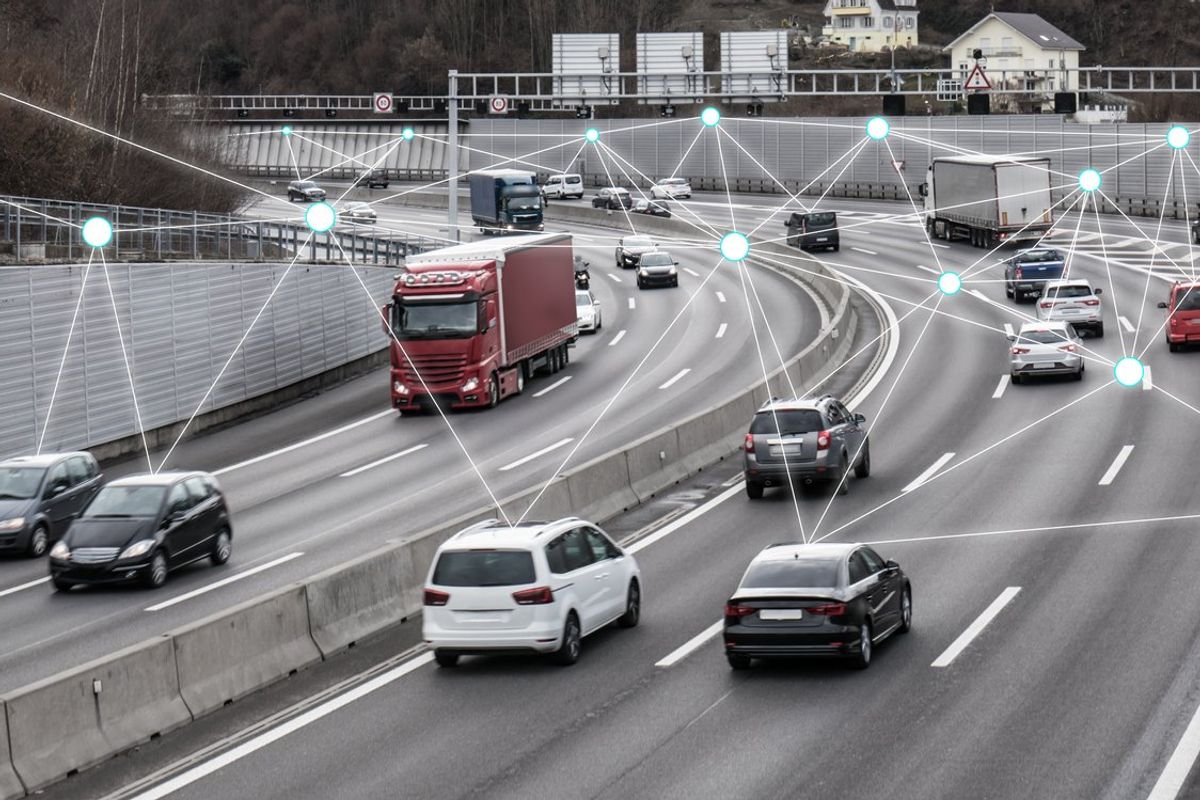Self Driving Cars

iStock
The Hidden Safety Features Making Autonomous Vehicles Safer Than You Think
Discover the advanced sensors, fail-safes, and cybersecurity technologies making autonomous vehicles safer than many human drivers.

Discover the advanced sensors, fail-safes, and cybersecurity technologies making autonomous vehicles safer than many human drivers.
A 2015 study reveals that human error leads to 94% of all traffic fatalities. Self-driving cars present a promising solution to this problem. The numbers tell a stark story - the National Highway Traffic Safety Administration reported 42,795 traffic deaths in 2022.
Self-driving cars might be safer than human drivers in many situations, contrary to popular belief. A newer study, published in Nature Communications by researchers, showed interesting results. They compared accident data from 2,100 autonomous driving systems with 35,113 human-driven vehicles. The findings indicated fewer accidents for self-driving cars in most scenarios. Waymo's safety record stands out - their vehicles showed better performance than humans at avoiding non-fatal accidents after covering seven million miles without a safety operator.
These vehicles still face some challenges. They crash almost twice as often during turns and five times more in low-light conditions. Understanding advanced safety features becomes a vital part of progress. The Insurance Institute for Highway Safety predicts 3.5 million vehicles with self-driving capability will hit U.S. roads next year.
State-of-the-art technologies make autonomous vehicles safer than most people think. Advanced sensor systems combine with redundant fail-safe mechanisms. Resilient cybersecurity measures work together to help eliminate human errors that cause most road fatalities today.

Self-driving vehicles rely on complex sensor networks that perceive their surroundings with accuracy far beyond the reach and capabilities of human senses. These sensory systems are the foundations of self-driving safety.
LIDAR (Light Detection and Ranging) technology works as the vehicle's eyes by sending laser pulses that build detailed three-dimensional maps of the surroundings. The system detects objects up to 200-300 meters away and measures more than a million points each second. LIDAR's exceptional depth perception surpasses human vision, enabling autonomous vehicles to pinpoint exact object locations and shapes immediately.
Today's LIDAR delivers a 360-degree field of view, providing a valuable means of gaining spatial awareness during complex driving scenarios, such as multi-exit intersections. Recent breakthroughs have created LIDAR systems that are approximately 1,000 times smaller than earlier versions. These systems blend into computer chips, which boosts reliability and cuts manufacturing costs.
Radar sensors work in conjunction with LIDAR, using radio waves to detect objects while measuring their distance and speed. These sensors excel when the weather turns bad and other sensors struggle. They work through fog, rain, and snow without issues. Radar systems can detect objects up to 250 meters away, and we used them mostly for adaptive cruise control and collision avoidance.
Ultrasonic sensors handle vital short-range detection tasks. These economical solutions send out ultrasonic impulses that bounce off nearby objects. They shine especially when you have parking assistance needs and close-proximity obstacle detection requirements.

High-resolution cameras gather visual data that autonomous vehicles need to spot traffic signs, lane markings, and pedestrians. Advanced systems use multiple cameras to create a smooth 360-degree viewpoint, often improved with High Dynamic Range (HDR) technology that handles tricky lighting conditions.
Camera data flows into sophisticated AI algorithms that classify and detect various objects while calculating distances between them. To name just one example, see how some autonomous vehicles use stereoscopic vision - it mimics human depth perception through multiple camera lenses placed at fixed distances apart.
The real magic happens through sensor fusion, where all system data comes together. Data from cameras, LIDAR, and radar creates redundant verification systems. When one sensor fails or misreads an object, others provide backup confirmation, which substantially improves overall safety.
Advanced sensors work alongside redundancy to create the backbone of autonomous vehicle safety. Self-driving cars have safety-critical systems designed with multiple backup layers that ensure proper functioning even when components fail.
Self-driving vehicles commonly use two separate processing systems that analyze sensor data simultaneously to achieve ASIL D safety compliance. These dual-processor setups enable what engineers call "fail-operational" capabilities, which means the system continues to function safely despite failures. Some designs utilize dual-core lockstep (DCLS) configurations, where similar computations run in parallel to detect and correct errors instantly.
The original autonomous vehicle prototypes needed multiple servers with high-end CPUs and GPUs that consumed over 5000 watts of power. Modern architectures work more efficiently while keeping redundancy intact. This parallel processing approach is different from human driving, where a single "processor" (the human brain) creates one point of failure.
Redundant braking systems feature two independent mechanisms that run on separate power sources. The secondary system activates automatically if the primary braking fails. Similarly, redundant steering systems help vehicles maintain directional control during emergencies. These systems must operate without human intervention for Level 4 autonomous driving, which enables vehicles to execute safe stops independently.
State-of-the-art systems maintain 50% steering capability even after primary system failure—enough to guide vehicles to a safe stop. This approach proves crucial as we move toward fully autonomous vehicles where drivers can't act as backup operators.
Power redundancy plays a crucial role as self-driving features become more sophisticated. Modern autonomous vehicles use dual battery systems with separate power sources placed strategically in different vehicle areas. These systems include advanced ultracapacitors that provide instant backup power to critical safety systems, such as steering and braking.
Ultracapacitors outperform traditional batteries at delivering quick power bursts and last longer, making them perfect for safety-critical backup needs. Some systems feature bidirectional controllers that allow both batteries to supply power to each other when needed, ensuring vital systems continue to run.
Self-driving vehicles now connect more than ever, making cybersecurity a vital part of their safety. These vehicles face unique security risks because they rely heavily on communication networks and complex software systems.
Strong encryption serves as the foundation for secure autonomous vehicle communications. Self-driving cars use powerful encryption protocols to protect data, whether it's stored or moving, which stops unauthorized access. This protection works across every communication channel - from internal networks like CAN (Controller Area Network) to external systems like V2X (Vehicle-to-Everything) communications.
Encryption guards against eavesdropping attacks that might steal sensitive details about a vehicle's location or destination. It helps maintain data integrity by identifying any unauthorized changes to critical information, such as navigation instructions or sensor data.
Car manufacturers now utilize Public Key Infrastructure (PKI) to streamline encryption processes. This system requires careful management of cryptographic keys to maintain a strong security framework throughout a vehicle's lifespan.
Intrusion Detection Systems (IDS) work as digital guards that watch for suspicious activities in autonomous vehicle networks. These systems work exceptionally well - one smart IDS framework caught 98% of attacks in IoV (Internet of Vehicles) environments.
Autonomous vehicles use several types of detection systems. Network-based IDSs watch traffic between devices in the vehicle's network and analyze network packets live to catch intrusions trying to exploit weaknesses. Host-based IDSs monitor activities in individual control units and sensors to detect suspicious behavior at the device level.
Advanced systems use Collaborative Intrusion Detection Networks (CIDN). These networks let vehicles share detection knowledge based on trust and make their individual IDS more accurate.
OTA updates give manufacturers a quick way to fix security vulnerabilities. These systems let them send critical security patches without physically touching the vehicles.
Secure OTA systems help carmakers quickly fix newly found vulnerabilities, which cuts down the time attackers have to exploit them. Regular updates address known issues and incorporate enhanced security features, such as advanced encryption methods and more sophisticated intrusion detection algorithms.
Security during updates remains crucial. Modern OTA systems use multiple layers of protection. They include secure boot processes after installation and can roll back failed updates. The system verifies the authenticity of each update using digital signatures. Updates get rejected automatically if signatures don't match.

Real-life performance data shows how autonomous vehicle safety features work beyond theoretical designs. These case studies highlight both achievements and challenges as the technology evolves.
Waymo has built an impressive safety record. Their vehicles logged over 50 million rider-only miles without a human driver through December 2024. The company's vehicles showed better results than human drivers on the same Phoenix and San Francisco routes. They had 83% fewer airbag deployment crashes, 81% fewer crashes causing injuries, and 64% fewer crashes reported to police. These numbers translate to 65 fewer airbag deployments, 154 fewer injury incidents, and 170 fewer police-reportable incidents. A Swiss Re study found that Waymo vehicles had no bodily injury claims and 76% fewer property damage claims compared to human-driven vehicles.

Tesla's Q4 2022 data reveals that vehicles using Autopilot technology had one crash per 4.85 million miles driven. This compares to one crash per 1.40 million miles without Autopilot. Despite this, regulators have increased their scrutiny following several incidents. The National Highway Traffic Safety Administration started an investigation when drivers reported 20 post-recall crashes. NHTSA's findings showed that "Tesla's weak driver engagement system was not appropriate for Autopilot's permissive operating capabilities". The biggest problem remains that Autopilot doesn't restrict usage to highway environments it was designed for.
An October 2023 incident with a Cruise autonomous vehicle exposed critical technical limitations. The AV hit a pedestrian who another vehicle had thrown into its path. The situation got worse when the Cruise AV made several errors. The vehicle was unable to locate the person after the impact. It confused a frontal collision for a side impact and misread its position relative to the curb. So instead of stopping immediately, the vehicle dragged the pedestrian 20 feet at 7.7 mph. Cruise later updated its software to fix these mechanisms. This illustrates how real-life incidents contribute to the improvement of safety measures.Still, when accidents involving autonomous vehicles happen, questions of liability and insurance can become very complex. That’s why it’s smart to get legal help after a motor vehicle accident, especially when technology failures may have contributed to the cras h.
Self-driving vehicles mark a major step toward safer transportation. This piece explores how autonomous technology tackles a big problem - 94% of traffic accidents stem from human error. Advanced sensor systems outperform human perception. LIDAR creates detailed 3D maps and radar systems work even in bad weather. Without doubt, these layered systems help vehicles stay aware when human drivers might struggle.
Multiple protection layers make autonomous vehicles even safer. Two processors analyze data simultaneously, while backup braking and steering systems are ready to take over if the main systems fail. This setup differs from human driving, which relies on a single decision-maker. These vehicles can keep running safely even when some parts fail - something regular cars can't do.
Strong cybersecurity measures protect these vehicles. Communication channels use end-to-end encryption, and threat detection systems spot 98% of potential issues. On top of that, manufacturers can patch vulnerabilities faster through OTA updates without touching the vehicles.
Real-life examples show both wins and challenges. Waymo's safety record surpasses that of human drivers in many ways. However, Tesla's Autopilot and Cruise's autonomous vehicles have revealed some limitations. These cases demonstrate that autonomous technology continually learns from each experience.
The technology continues to improve in addressing existing issues. Data shows that autonomous vehicles already drive better than humans in many situations, although some areas still require improvement. The combination of advanced sensors, backup systems, and robust cybersecurity creates a foundation that could significantly reduce the 43,000 yearly traffic fatalities on our roads.
GearBrain Compatibility Find Engine
A pioneering recommendation platform where you can research,
discover, buy, and learn how to connect and optimize smart devices.
Join our community! Ask and answer questions about smart devices and save yours in My Gear.
